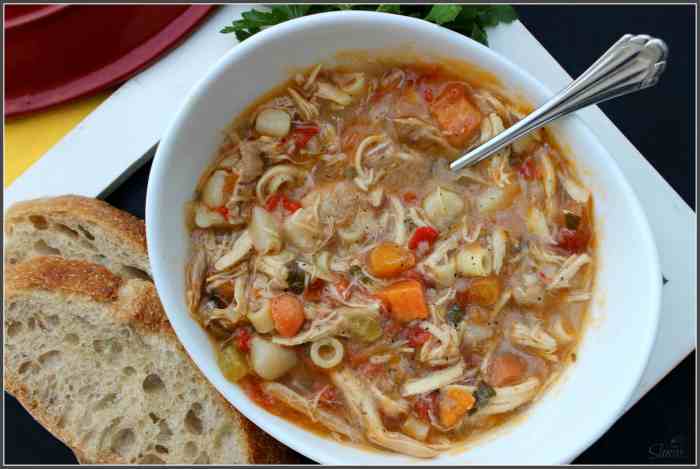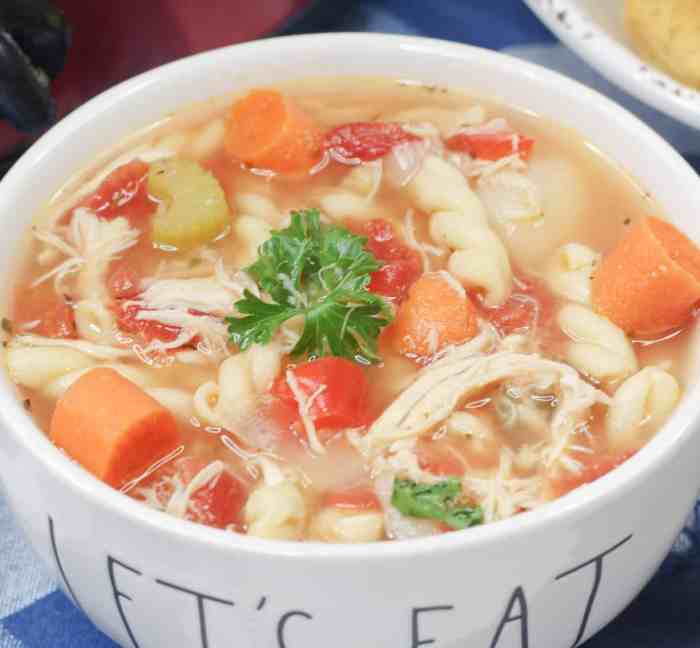Sicilian Chicken Soup: Regional Variations and Culinary Traditions: Sicilian Chicken Soup Recipe
Sicilian chicken soup recipe – This article delves into the diverse world of Sicilian chicken soup, exploring regional variations, key ingredients, cooking techniques, serving suggestions, historical context, and nutritional aspects. We’ll uncover the secrets behind this comforting and flavorful dish, highlighting its cultural significance and adaptability.
Regional Variations in Sicilian Chicken Soup
Sicilian chicken soup boasts a rich tapestry of regional variations, each reflecting the unique culinary traditions of its area. Three distinct recipes highlight these differences: a palermesan-infused soup from the western coast, a heartier, vegetable-rich version from the mountainous central region, and a citrus-brightened soup from the eastern coast.
The western coastal version emphasizes a lighter broth, achieved through careful simmering of chicken and the addition of finely grated Parmigiano-Reggiano cheese for richness. Herbs like parsley and basil are used sparingly, allowing the delicate chicken flavor to shine. Bone-in chicken is preferred, simmered for at least 2 hours to extract maximum flavor.
The central region’s mountainous terrain influences its soup, featuring a robust broth brimming with vegetables such as carrots, celery, and potatoes. Dried oregano and fennel seeds add warmth and complexity, while the chicken (often bone-in) simmers for a longer duration (2.5-3 hours) to achieve a deeper, more intense flavor.
The eastern coastal variant showcases the region’s abundant citrus fruits. Lemon juice and zest are added towards the end of cooking, providing a bright, refreshing counterpoint to the rich chicken broth. This version typically uses boneless chicken breasts, simmered for a shorter period (1.5-2 hours) to maintain tenderness. Fresh basil and a hint of red pepper flakes add further vibrancy.
| Recipe Region | Chicken Type | Simmer Time | Key Herbs & Spices |
|---|---|---|---|
| Western Coast | Bone-in | 2+ hours | Parsley, Basil, Parmigiano-Reggiano |
| Central Mountains | Bone-in | 2.5-3 hours | Oregano, Fennel Seeds |
| Eastern Coast | Boneless | 1.5-2 hours | Basil, Lemon Zest & Juice, Red Pepper Flakes |
Key Ingredients and Their Roles in Sicilian Chicken Soup
The distinctive flavor of Sicilian chicken soup stems from a careful selection of high-quality ingredients. Each component plays a crucial role in creating the soup’s unique character.
- Chicken: Provides the foundation of the broth, contributing richness and umami flavor. Bone-in chicken offers a more intense flavor, while boneless chicken maintains tenderness.
- Tomatoes: Adds acidity and sweetness, balancing the richness of the chicken broth. San Marzano tomatoes are traditionally preferred for their sweetness and low acidity.
- Herbs: Basil, parsley, oregano, and fennel seeds add aromatic complexity and depth of flavor. The choice of herbs varies regionally.
- Pasta (optional): Adds heartiness and texture to the soup. Small pasta shapes like ditalini or tiny shells are commonly used.
- Vegetables (optional): Carrots, celery, and potatoes contribute sweetness and nutrients, varying in quantity depending on the regional variation.
Substitutions for hard-to-find ingredients should be made carefully to maintain the overall flavor profile. For instance, if San Marzano tomatoes are unavailable, high-quality canned plum tomatoes can be used as a substitute.
Cooking Techniques and Methods for a Classic Sicilian Chicken Soup, Sicilian chicken soup recipe
Preparing authentic Sicilian chicken soup involves a straightforward yet nuanced process. Careful attention to simmering time and ingredient additions is key to achieving the desired flavor and texture.
- Sauté aromatics (onions, carrots, celery) in olive oil until softened.
- Add chicken pieces and cook until lightly browned.
- Pour in water or broth, bring to a boil, then reduce heat and simmer for the appropriate time depending on the chosen recipe (see table above).
- Add tomatoes, herbs, and optional vegetables. Continue simmering.
- Season with salt and pepper to taste.
- If using pasta or rice, add during the last 10-15 minutes of cooking time.
- Stir in lemon zest and juice (if using) during the last few minutes.
- Remove from heat and let rest for a few minutes before serving.
Over-simmering can lead to a mushy texture, while under-simmering may result in a less flavorful broth. Adjusting the simmering time based on the chicken type and desired texture is crucial.
Serving and Presentation of Sicilian Chicken Soup

Source: adashofsanity.com
Traditionally, Sicilian chicken soup is served in warm, shallow bowls. The soup should have a vibrant, appealing color, reflecting the ingredients used. The texture should be balanced, with tender chicken and perfectly cooked vegetables.
Garnishes such as freshly chopped parsley, a drizzle of extra virgin olive oil, and a sprinkle of grated Parmigiano-Reggiano cheese enhance both the visual appeal and flavor of the soup. A simple lemon wedge adds a refreshing touch.
Imagine a rustic setting, perhaps a sun-drenched trattoria or a cozy kitchen. The aroma of simmering chicken and herbs fills the air. The soup is served alongside crusty bread, perfect for soaking up the flavorful broth. The simple pleasure of sharing this warm, comforting soup with loved ones creates a truly memorable dining experience.
Historical and Cultural Context of Sicilian Chicken Soup

Source: sweetpeaskitchen.com
Sicilian chicken soup’s origins are deeply rooted in the island’s rich culinary history, influenced by various cultures that have shaped its identity. The use of readily available ingredients and simple cooking techniques reflect the island’s agricultural traditions.
The soup holds a significant place in Sicilian culinary traditions, often served as a comforting dish during colder months or as a celebratory meal. Many families have their own unique recipes passed down through generations, adding to the soup’s cultural richness and personal significance.
Anecdotes about the soup often involve family gatherings and celebrations, highlighting its role in fostering togetherness and sharing cultural heritage. It represents more than just a meal; it embodies a sense of community and connection to the past.
Nutritional Aspects of Sicilian Chicken Soup
Sicilian chicken soup is not only delicious but also nutritious, offering a variety of health benefits. The chicken provides protein, while vegetables contribute vitamins and minerals. The broth itself is a good source of electrolytes.
To enhance the soup’s health benefits, leaner cuts of chicken can be used, and sodium intake can be reduced by using less salt and opting for low-sodium broth. Increasing the proportion of vegetables further boosts the nutritional value.
| Nutrient | Approximate Value (per serving) |
|---|---|
| Calories | 250-350 (varies based on ingredients and portion size) |
| Protein | 20-30g |
| Fat | 5-15g |
| Sodium | Variable (reduce by using low-sodium broth and less salt) |
Frequently Asked Questions
Can I use frozen chicken?
Yes, thawed frozen chicken works well. Ensure it’s fully thawed before adding it to the soup.
What type of pasta is traditionally used?
Small pasta shapes like ditalini or small shells are common, but you can adapt to your preference.
How can I make this soup vegetarian?
Substitute the chicken with hearty vegetables like chickpeas, lentils, or cannellini beans for a vegetarian version.
How long can I store leftover soup?
Store leftovers in an airtight container in the refrigerator for up to 3 days.
